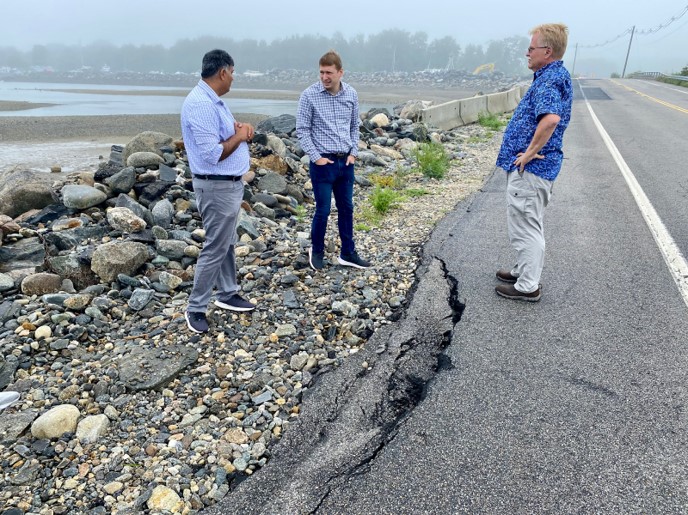In early August, leadership from NOAA’s National Ocean Service (NOS) visited NCCOS-funded project sites in New Hampshire to discuss ongoing coastal pavement resilience research.
Coastal communities rely almost exclusively on their road networks for transportation of people, goods, and services, making the integrity of these networks key to community resilience in the face of sea level rise. Both gradual changes in sea level rise and extreme events deteriorate pavement over time, triggering pavement failures that require reconstruction. Despite these significant impacts, the exact process of how multiple coastal hazards over time deteriorate pavement, and interventions that would slow or stop this process, are not well understood.

Led by researchers at the University of New Hampshire, this project examines linkages between coastal hazards and pavement damage, and identifies the coastal processes that cause pavement deterioration. Scientists are evaluating adaptation alternatives, specifically those incorporating nature-based solutions, that will lessen the effects of coastal processes to help mitigate pavement damage and deterioration.
Researchers and managers showed NOS leadership several vulnerable shorelines along the New Hampshire coast that highlight how road life expectancy has been shortened by flooding; roads have been on a typical 10-20 year repavement timeline, but many parts of New Hampshire’s route 1A are now on a 3-5 year repavement cycle due to accelerated damages (see photo). The group discussed the types of actions transportation professionals can take to avoid flooding impacts in these places (both natural or traditional engineering approaches), how much pavement degradation is tied to gradual changes in sea level rise compared to extreme storm events, and how adaptation options may differ from site to site. This was an opportunity for NOS leadership to see first-hand the importance of leveraging partnerships with transportation agencies, who manage roadways, to enhance the coastal resilience of communities.
Project outputs will include a toolkit for road planners and decision makers to identify effective adaptation alternatives for coastal roadways to increase their sea level rise resilience. This project is supported by the NCCOS Effects of Sea Level Rise (ESLR) Program as part of the Surface Transportation Resilience Funding Opportunity, an outcome of a partnership with the U.S. Department of Transportation’s Federal Highways Administration (FHWA). The project is one of four that is co-managed by a NOAA and a FHWA expert.
Visit the NOAA Sea Level Rise Portal for helpful resources from NOAA and other federal agencies.
